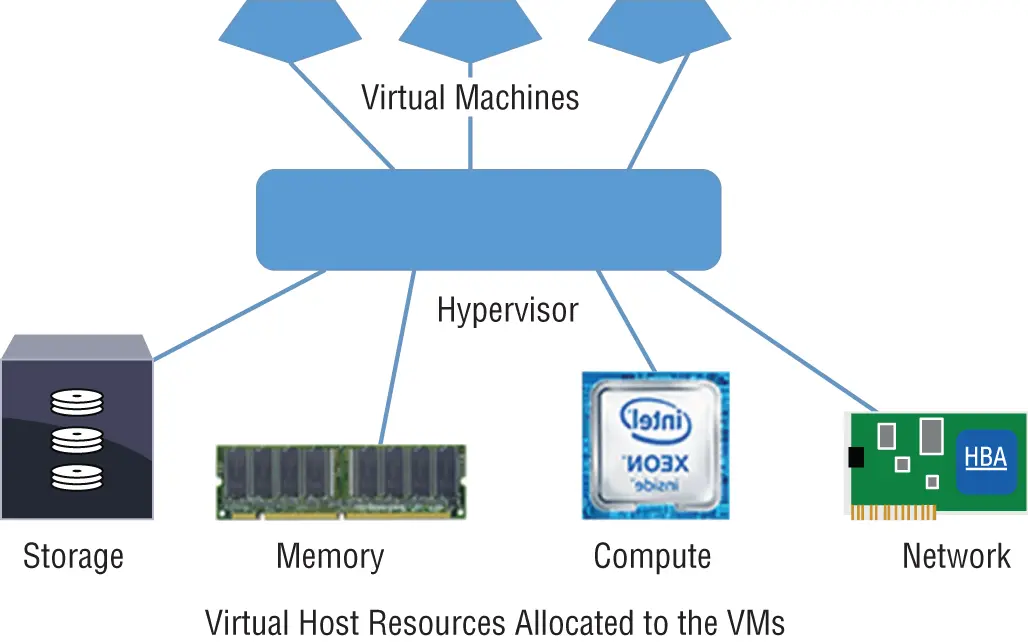In this section, I will go deeper into the technology architectures and processes that you'll find in the world of cloud computing. It is important to see how much of an effect virtualization has had in the creation of cloud computing and to understand the process of taking physical hardware resources, virtualizing them, and then assigning these resources to systems and services running in the virtualized data center.
The Cloud Shared Resource Pooling Model
Every cloud service depends on resource pooling. Resource pooling is when the cloud service provider virtualizes physical resources into a group, or pool, and makes these pooled resources available to customers. The underlying physical resources are then dynamically allocated and reallocated as the demand requires. Recall the NIST definition of cloud computing as “a model for enabling convenient, on-demand network access to a shared pool of configurable computing resources …” Resource pooling is a defining feature of the cloud.
Resource pooling hides the physical hardware from the customer and allows many customers to share resources such as storage, compute power, and network bandwidth. This concept is also called multitenancy. We'll look at some examples of these pooled resources in the following sections.
In the cloud provider's data center, there are numerous physical servers that each run a hypervisor. When you provision a VM in the cloud, the provider's cloud orchestration platform selects an available physical server to host your VM. The important point here is that it doesn't matter which particular host you get. Your VM will run the same regardless of the host. In fact, if you were to stop a running VM and then restart it, it would likely run on a completely different host, and you wouldn't be able to tell the difference. The physical servers that the provider offers up for your VMs to run on are part of a singular compute pool . By pooling physical servers in this way, cloud providers can flexibly dispense computing power to multiple customers. As more customers enter the cloud, the provider just has to add more servers to keep up with demand.
Drilling down a bit into the technical details, the hypervisor on each host will virtualize the physical server resources and make them available to the VM for consumption. Multiple VMs can run on a single physical host, so one of the hypervisor's jobs is to allow the VMs to share the host's resources while remaining isolated from one another so that one VM can't read the memory used by another VM, for instance. Figure 1.14shows this relationship between the virtual machines and the hardware resources.

FIGURE 1.14 Shared resource pooling
The hypervisor's job is to virtualize the host's CPUs, memory, network interfaces, and—if applicable—storage (more on storage in a moment). Let's briefly go over how the hypervisor virtualizes CPU, memory, and network interfaces.
On any given host, there's a good chance that the number of VMs will greatly outnumber the host's physical CPU cores. Therefore, the hypervisor must coordinate or schedule the various threads run by each VM on the host. If the VMs all need to use the processor simultaneously, the hypervisor will figure out how to dole out the scarce CPU resources to the VMs contending for it. This process is automatic, and you'll probably never have to think about it. But you should know about another “affinity” term that's easy to confuse with hypervisor affinity: CPU affinity. CPU affinity is the ability to assign a processing thread to a core instead of having the hypervisor dynamically allocate it. A VM can have CPU affinity enabled, and when a processing thread is received by the hypervisor, it will be assigned to the CPU it originally ran on. You're not likely to see it come up on the exam, but just be aware that CPU affinity can and often does result in suboptimal performance, so it's generally best to disable it. A particular CPU assigned to a VM can have a very high utilization rate while another CPU might be sitting idle; affinity will override the hypervisor's CPU selection algorithms and be forced to use the saturated CPU instead of the underutilized one.
Now let's talk about random access memory (RAM). Just as there are a limited number of CPU cores, so there is a finite amount of RAM installed in the physical server. This RAM is virtualized by the hypervisor software into memory pools and allocated to virtual machines. When you provision a VM, you choose the amount of RAM to allocate to it. Unlike the CPU, which is shared, RAM is not. Whatever RAM you allocate to a VM is dedicated to that VM, and no other VM can access it. When a VM consumes all of its allocated RAM, it will begin to swap the contents of some of its RAM to storage. This swap file , as it is called, will be used as virtual RAM. When configuring a VM, be sure to allocate enough storage space for the swap file, and keep in mind that the storage latency of the swap file will have a negative impact on the performance of the VM.
Thus far, we've discussed compute pools from the perspective of an IaaS model. But how do compute pools work with PaaS or SaaS models? Behind the scenes, almost everything's the same. What's different is that in the PaaS and SaaS models, the cloud provider runs a user-friendly interface atop the underlying compute infrastructure. For example, if the cloud provider is offering hosted email as a service, that email system gets its computing power from the same compute pools that power the IaaS infrastructure. In fact, every service under the PaaS or SaaS model that the provider offers probably runs directly on the same IaaS infrastructure that we've been discussing. In other words, cloud providers don't reinvent the wheel for every service that they provide. They build the compute infrastructure to provide the compute pools, and everything else uses those.
Cloud providers also virtualize and pool network resources. If you're not familiar with the details of networking, what happens behind the scenes can be a bit difficult to grasp, so we'll start in familiar territory.
The term network is a loaded term because its meaning varies with context. Generally, a network is the infrastructure that allows communication between computing resources, such as two servers or an end user and a server. That much you already know, but here's where it gets complicated. In the cloud, there are two different levels of networking:
The Underlay The underlying network (or underlay) consists of the physical network infrastructure that the cloud provider completely manages. This is transparent to you, and you have no visibility into it whatsoever.
The Overlay The cloud provider allows customers to create and manage virtual networks that run atop the provider's underlying network. These are sometimes called overlay networks or virtual private clouds (VPCs). Virtual networks are what you'll actually work with and connect your cloud resources to. In simple terms, a VPC is a private, software-defined network that exists in the cloud.
A virtual network consists of, at a minimum, a block of private IP addresses to be assigned to VMs and other network resources, such as DNS and DHCP servers. A virtual network can span multiple physical hosts—a VM running on one host can communicate with another VM running on a different host, as if they were on the same subnet. Naturally, you can connect a virtual network to an external network such as the Internet or a corporate network via a VPN.
Читать дальше













